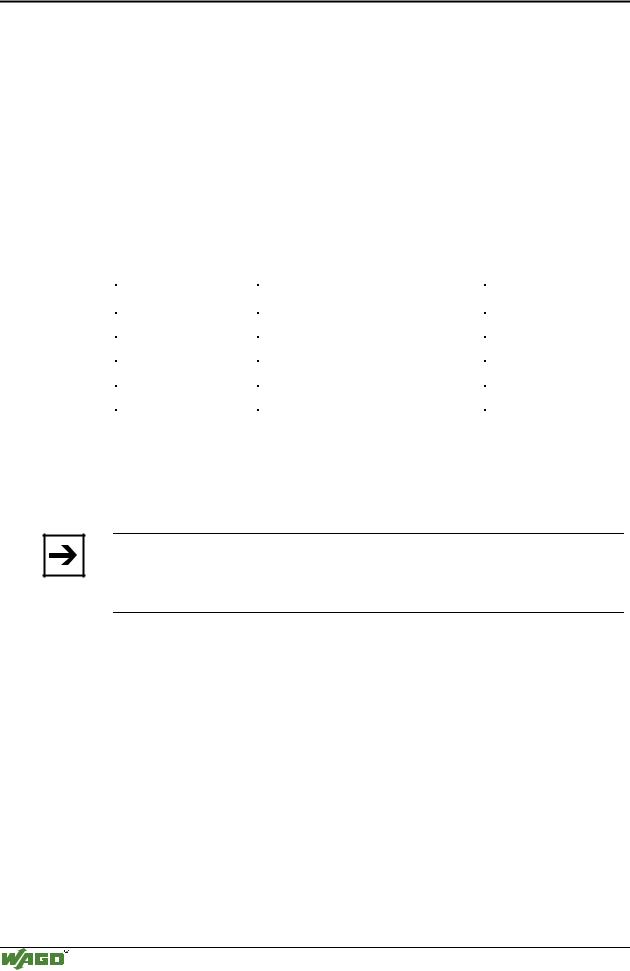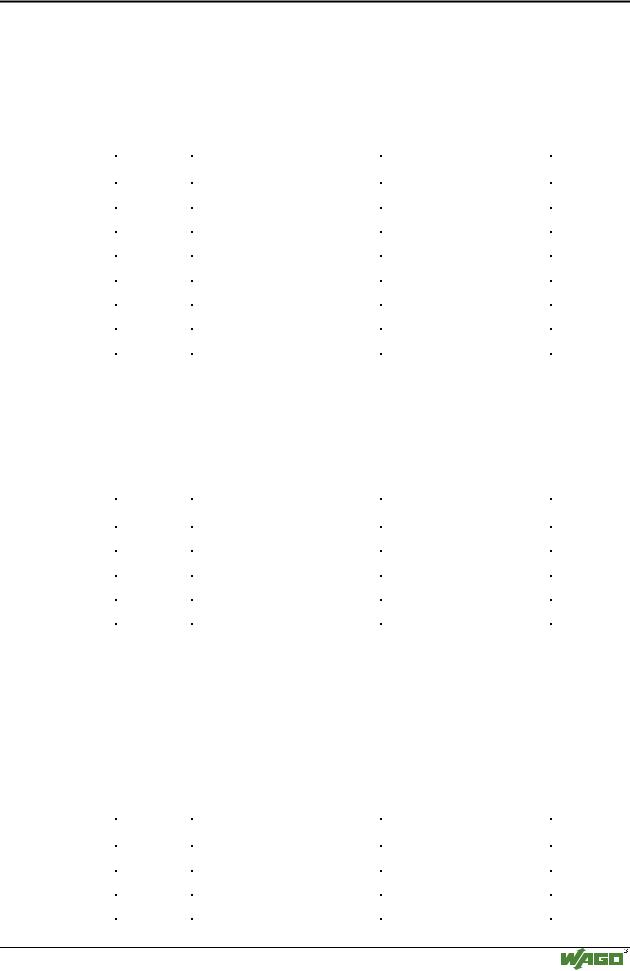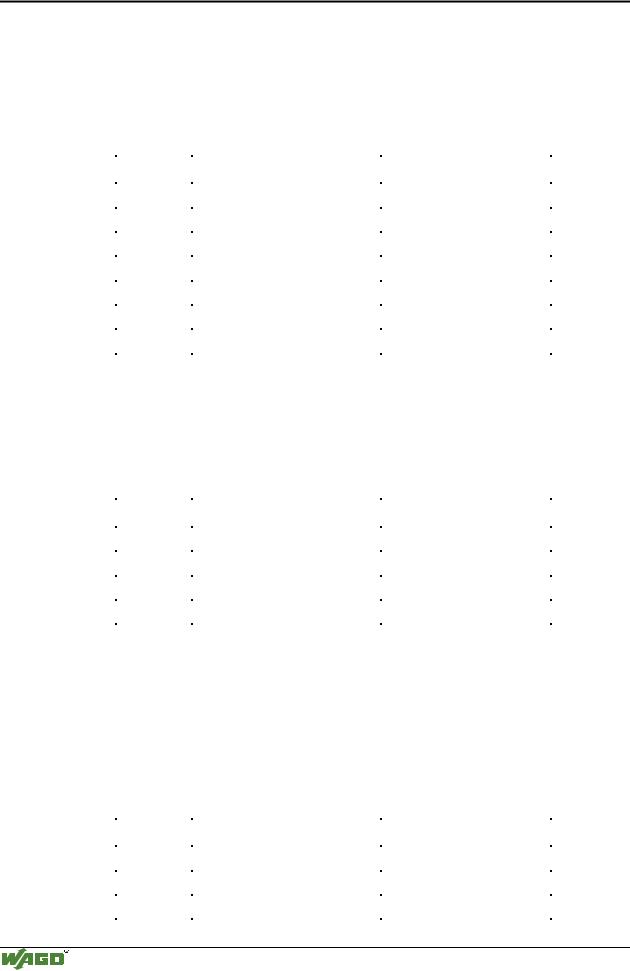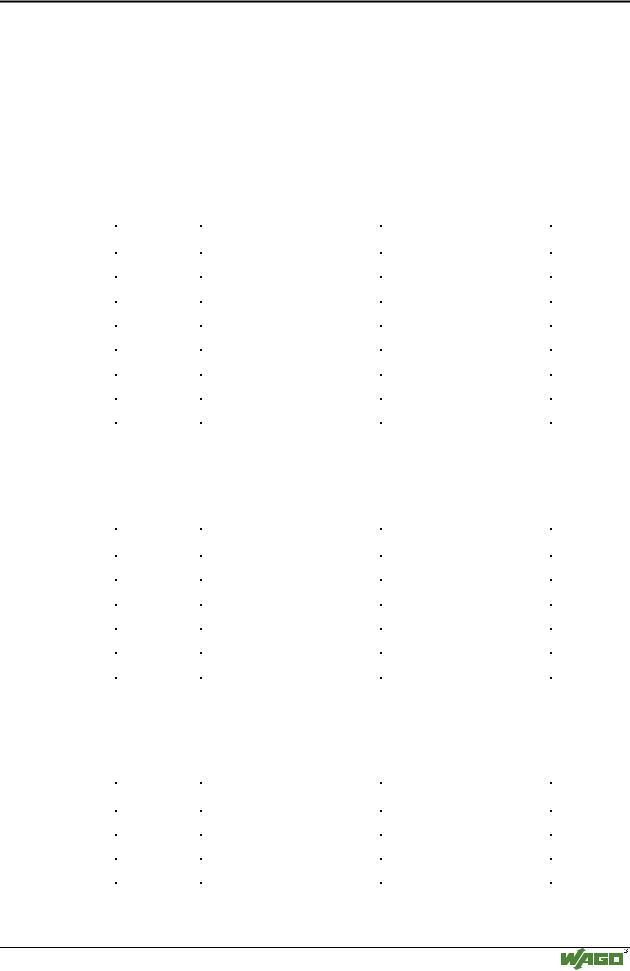
- •TABLE OF CONTENTS
- •Important comments
- •Legal principles
- •Copyright
- •Personnel qualification
- •Intended use
- •Scope
- •Symbols
- •Font conventions
- •Number notation
- •Abbreviation
- •The WAGO-I/O-SYSTEM 750
- •System Description
- •General
- •Coupler/Controller (1)
- •I/O Modules (2)
- •End Module (3)
- •Installation
- •Safty notes
- •Mechanical Installation
- •Electrical Installation
- •Wire Connection
- •Change fuse
- •Power supply
- •System supply voltage
- •Supply Voltage Field Side
- •Manufacturing Number
- •Technical Data
- •Fieldbus coupler / controller
- •Fieldbus coupler 750-342
- •Description
- •Hardware
- •View
- •Device supply
- •Fieldbus connection
- •Display elements
- •Configuration interface
- •Operating system
- •Process image
- •Example of a process input image
- •Example of a process output image
- •Process data architecture for MODBUS/TCP
- •Data exchange
- •Memory areas
- •Addressing
- •Data exchange between MODBUS master and I/O modules
- •Starting up ETHERNET TCP/IP fieldbus nodes
- •Connecting PC and fieldbus node
- •Determining IP addresses
- •Allocating the IP address to the fieldbus node
- •Testing the function of the fieldbus node
- •Reading out the information as HTML pages
- •LED Display
- •Blink code
- •Fieldbus status
- •Node status
- •Fault behavior
- •Fieldbus failure
- •Internal bus fault
- •Technical Data
- •Fieldbus controller 750-842
- •Description
- •Hardware
- •View
- •Device supply
- •Fieldbus connection
- •Display elements
- •Configuration and programming interface
- •Operating mode switch
- •Operating system
- •Start-up
- •PLC cycle
- •Process image
- •Example of a process input image
- •Example of a process output image
- •Process data architecture for MODBUS/TCP
- •Data exchange
- •Memory areas
- •Addressing
- •Data exchange between master and I/O modules
- •Data exchange between PLC functionality (CPU) and I/O modules
- •Data exchange between master and PLC functionality (CPU)
- •Common access of MODBUS master and PLC functionality to outputs
- •Address review
- •Starting up ETHERNET TCP/IP fieldbus nodes
- •Connecting PC and fieldbus node
- •Determining IP addresses
- •Allocating the IP address to the fieldbus node
- •Testing the function of the fieldbus node
- •Viewing the HTML pages
- •Programming the PFC with WAGO-I/O-PRO 32
- •LED Display
- •Blink code
- •Fieldbus status
- •Node status
- •Supply voltage status
- •Fault behavior
- •Fieldbus failure
- •Internal bus fault
- •Technical Data
- •I/O modules
- •I/O modules-Review
- •Digital Inputs
- •Digital Outputs
- •Analog Inputs
- •Analog Outputs
- •Supply and End modules
- •Terminal blocks for encoder and resolvers
- •Special terminal blocks
- •ETHERNET
- •Network architecture – Principles and Regulations
- •Transmission media
- •Network topologies
- •Coupler modules
- •Important terms
- •Network communication
- •Channel access method
- •Communication protocols
- •ETHERNET
- •IP-Protocol
- •TCP protocol
- •ICMP
- •Application protocols
- •MODBUS/TCP
- •Bootstrap Protocol (BootP)
- •HyperText Transfer Protocol (HTTP)
- •Common MODBUS functions
- •Use of the MODBUS functions
- •Description of the MODBUS functions
- •Function code FC1 (Read Coils)
- •Function code FC2 (Read Discrete Inputs)
- •Function code FC3 (Read multiple registers)
- •Function code FC4 (Read input registers)
- •Function code FC5 (Write Coil)
- •Function code FC6 (Write single register)
- •Function code FC7 (Read Exception Status)
- •Function code FC16 (Write multiple registers)
- •Function code FC11 (Get comm event counter)
- •Function code FC23 (Read/Write multiple registers)
- •Watchdog (Fieldbus failure)
- •Diagnostic function
- •Configuration function
- •Firmware information
- •General Registers
- •Special PFC Register (only for controller 750-842)
- •Application examples
- •Test of MODBUS protocol and fieldbus nodes
- •Visualization and control using SCADA software
- •Application in Explosive Environments
- •Foreword
- •Protective measures
- •Classification meeting CENELEC and IEC
- •Divisions
- •Explosion protection group
- •Unit categories
- •Temperature classes
- •Types of ignition protection
- •Classifications meeting the NEC 500
- •Divisions
- •Explosion protection groups
- •Temperature classes
- •Identification
- •For Europe
- •For America
- •Installation regulations
- •Glossary
- •Literature list
- •Index

282 • Common MODBUS functions Description of the MODBUS functions
6.2 Description of the MODBUS functions
All MODBUS functions in the WAGO ETHERNET fieldbus coupler and controller are executed as follows:
When a function code is entered, the MODBUS master (i.e. PC) makes a request to the coupler/controller of the fieldbus node.
Subsequently, the coupler/controller sends a datagram to the master as a response.
If the coupler receives an incorrect request, it sends an error datagram (Exception) to the master.
The exception code contained in the exception has the following meaning:
Exception Code |
Meaning |
0x01 |
Illegal Function |
|
|
0x02 |
Illegal Data Address |
|
|
0x03 |
Illegal Data Value |
|
|
0x04 |
Slave Device Failure |
|
|
The following chapters describe the datagram architecture of request, response and exception with examples for each function code.
Note
In the case of the read functions (FC1 – FC 4) the outputs can be additionally written and read back by adding an offset of 200hex (0x0200) to the MODBUS address.
Modular I/O System
ETHERNET TCP/IP

Common MODBUS functions • 283
Function code FC1 (Read Coils)
6.2.1Function code FC1 (Read Coils)
The function reads the status of the input and output bits (coils) in slave.
Request
The request determines the starting address and the number of bits to be read. Example: An inquiry, with which the bits 0 to 7 are to be read.
Byte |
Field name |
Example |
Byte 0, 1 |
Transaction identifier |
0x0000 |
|
|
|
Byte 2, 3 |
protocol identifier |
0x0000 |
|
|
|
Byte 4, 5 |
length field |
0x0006 |
|
|
|
Byte 6 |
unit identifier |
0x01 not used |
|
|
|
Byte 7 |
MODBUS function code |
0x01 |
|
|
|
Byte 8, 9 |
reference number |
0x0000 |
|
|
|
Byte 10, 11 |
Bit count |
0x0008 |
|
|
|
Response
The current values of the inquired bits are packed in the data field. A 1 corresponds to the ON status and a 0 to the OFF status. The lowest value bit of the first data byte contains the first bit of the inquiry. The others follow in ascending order. If the number of inputs is not a multiple of 8, the remaining bits of the last data byte are filled with zeroes (truncated).
Byte |
Field name |
Example |
..... |
|
|
|
|
|
Byte 7 |
MODBUS function code |
0x01 |
|
|
|
Byte 8 |
Byte count |
0x01 |
|
|
|
Byte 9 |
Bit values |
0x12 |
|
|
|
The status of the inputs 7 to 0 is shown as byte value 0x12 or binary 0001 0010.
Input 7 is the bit having the highest significance of this byte and input 0 the lowest value.
The assignment is thus made from 7 to 0 with OFF-OFF-OFF-ON-OFF-OFF-
ON-OFF. |
|
|
|
|
|
|
|
|
|
Bit: |
0 |
0 |
0 |
1 |
0 |
0 |
1 |
0 |
|
Coil: |
7 |
6 |
5 |
4 |
3 |
2 |
1 |
0 |
|
Exception |
|
|
|
|
|
|
|
|
|
|
|
|
|
|
|
|
|||
Byte |
|
Field name |
|
|
|
Example |
|||
..... |
|
|
|
|
|
|
|
|
|
|
|
|
|
||||||
Byte 7 |
|
MODBUS function code |
0x81 |
||||||
|
|
|
|
|
|
|
|||
Byte 8 |
|
Exception code |
|
|
|
0x01 or 0x02 |
|||
|
|
|
|
|
|
|
|
|
|
Modular I/O System
ETHERNET TCP/IP

284 • Common MODBUS functions Function code FC2 (Read Discrete Inputs)
6.2.2Function code FC2 (Read Discrete Inputs)
This function reads the input bits in the slave.
Requests
The request determines the starting address and the number of bits to be read. Example: An inquiry with which the bits 0 to 7 are to be read:
Byte |
Field name |
Example |
Byte 0, 1 |
Transaction identifier |
0x0000 |
|
|
|
Byte 2, 3 |
protocol identifier |
0x0000 |
|
|
|
Byte 4, 5 |
Length field |
0x0006 |
|
|
|
Byte 6 |
unit identifier |
0x01 not used |
|
|
|
Byte 7 |
MODBUS function code |
0x02 |
|
|
|
Byte 8, 9 |
reference number |
0x0000 |
|
|
|
Byte 10, 11 |
Bit count |
0x0008 |
|
|
|
Response
The current value of the inquired bit is packed into the data field. A 1 corresponds to the ON status and a 0 the OFF status. The lowest value bit of the first data byte contains the first bit of the inquiry. The others follow in an ascending order. If the number of inputs is not a multiple of 8, the remaining bits of the last data byte are filled with zeroes (truncated).
Byte |
Field name |
Example |
..... |
|
|
|
|
|
Byte 7 |
MODBUS function code |
0x02 |
|
|
|
Byte 8 |
Byte count |
0x01 |
|
|
|
Byte 9 |
Bit values |
0x12 |
|
|
|
The status of the inputs 7 to 0 is shown as a byte value 0x12 or binary 0001 0010.
Input 7 is the bit having the highest significance of this byte and input 0 the lowest value.
The assignment is thus made from 7 to 0 with OFF-OFF-OFF-ON-OFF-OFF-
ON-OFF. |
|
|
|
|
|
|
|
|
|
Bit: |
0 |
0 |
0 |
1 |
0 |
0 |
1 |
0 |
|
Coil: |
7 |
6 |
5 |
4 |
3 |
2 |
1 |
0 |
|
Exception |
|
|
|
|
|
|
|
|
|
|
|
|
|
|
|
|
|||
Byte |
|
Field name |
|
|
|
Example |
|||
..... |
|
|
|
|
|
|
|
|
|
|
|
|
|
||||||
Byte 7 |
|
MODBUS function code |
0x82 |
||||||
|
|
|
|
|
|
|
|||
Byte 8 |
|
Exception code |
|
|
|
0x01 or 0x02 |
|||
|
|
|
|
|
|
|
|
|
|
Modular I/O System
ETHERNET TCP/IP

Common MODBUS functions • 285
Function code FC3 (Read multiple registers)
6.2.3Function code FC3 (Read multiple registers)
The binary contents of holding registers are read from the slave using this function.
Request
The request determines the start word address (start register) and the number the register to be read. The addressing starts with 0.
Example: An inquiry of the registers 0 and 1:
Byte |
Field name |
Example |
Byte 0, 1 |
Transaction identifier |
0x0000 |
|
|
|
Byte 2, 3 |
protocol identifier |
0x0000 |
|
|
|
Byte 4, 5 |
length field |
0x0006 |
|
|
|
Byte 6 |
unit identifier |
0x01 not used |
|
|
|
Byte 7 |
MODBUS function code |
0x03 |
|
|
|
Byte 8, 9 |
reference number |
0x0000 |
|
|
|
Byte 10, 11 |
Word count |
0x0002 |
|
|
|
Response
The reply register data is packed as 2 bytes per register. The first byte contains the higher value bits, the second the lower values.
Byte |
Field name |
Example |
..... |
|
|
|
|
|
Byte 7 |
MODBUS function code |
0x03 |
|
|
|
Byte 8 |
Byte count |
0x04 |
|
|
|
Byte 9, 10 |
Value Register 0 |
0x1234 |
|
|
|
Byte 11, 12 |
Value Register 1 |
0x2345 |
|
|
|
The contents of register 0 are displayed by the value 0x1234 and the contents of register 1 is 0x2345.
Exception |
|
|
|
|
|
Byte |
Field name |
Example |
..... |
|
|
|
|
|
Byte 7 |
MODBUS function code |
0x83 |
|
|
|
Byte 8 |
Exception code |
0x01 or 0x02 |
|
|
|
Modular I/O System
ETHERNET TCP/IP
